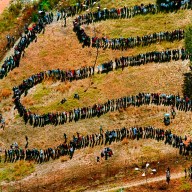Harry Lumsden is 86 and has been formally retired for more than 20 years. But he can still wrestle a trumpeter swan almost as fast as his daughter.
Don’t worry, he doesn’t wrestle them for fun or sport. It’s to tag the large birds so they can be counted and tracked.
Lumsden grew up in Scotland and always loved animals. He visited Canada during the Second World War when he was a member of the Royal Air Force. He liked the country and was offered a job with the Ontario Ministry of Natural Resources in 1948. “They couldn’t get any biologist from universities, there were no graduates after the war. They took a gamble on me,” he says.
In the 40 years he spent with the ministry as a research scientist, Lumsden worked with geese, ducks, grouse and deer. In 1982, while working out of a research station in Maple, Ont., Lumsden and his colleagues were assigned the task of bringing trumpeter swans back to the province.
Trumpeter swans are the largest waterfowl in the world (smaller mute swans are much more common: they have an orange beak with a knob on it while trumpeters have a black one) and they had been heavily hunted in Ontario since the 1700s. The very last one was shot at Long Point in 1886. “A part of our heritage was destroyed,” says Lumsden.
To start, Lumsden got eggs from Alberta, hatched them in incubators and used mute swans to raise the cygnets. Later, he bought breeding pairs from the United States.
He set the swans up on ponds near Maple (the locals, usually farmers who owned the ponds, would keep an eye on them and feed them) and they multiplied over the years.
When Lumsden retired in 1988, he arranged with the ministry to keep on with his work. He still tags, tracks and organizes data — which has just recently been put on computer — on the now 1,400 trumpeter swans in the province. His daughter Diana helps him out, particularly with computer-related work.
Volunteers at Wye Marsh in Midland and La Salle Park in Burlington — where 160 trumpet and 100 mute swans lived last winter — help tag and feed the swans.
Lumsden travels a little to see swans around Ontario, but mostly sticks close to his home in Aurora, Ont., where he gardens, hunts a little, and feeds the swans on his own pond. “Why should one relax? That’s a prescription for an early grave.”
• If you see a trumpeter swan in Ontario, make a note of the letters and numbers on its yellow tag and either call the Ministry of Natural Resources or email Harry Lumsden at theholtentwo@rogers.com.
















